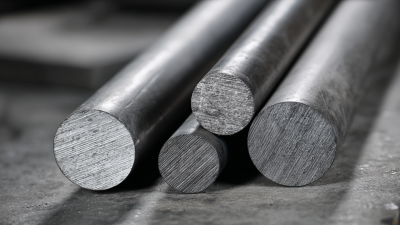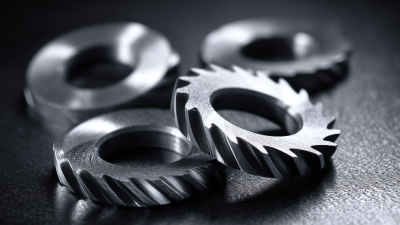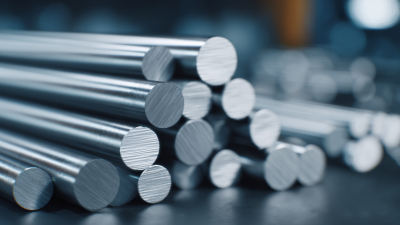The Evolution of Circular Blades in Modern Manufacturing Techniques
 The modern manufacturing landscape is continuously evolving, with innovations enhancing production efficiency and precision. Among the pivotal advancements, Circular Blades play a crucial role in various applications, from metalworking to woodworking. According to a 2022 report by Research and Markets, the global circular saw market is projected to reach USD 5.6 billion by 2027, fueled by the demand for high-performance cutting tools in industries such as construction and automotive. Furthermore, the integration of advanced materials and cutting-edge manufacturing techniques has significantly improved the durability and performance of Circular Blades. As industries strive for sustainability and efficiency, understanding the evolution of these tools becomes essential. This guide will delve into the advancements and technological innovations in Circular Blades, highlighting how they are shaping contemporary manufacturing processes and contributing to enhanced productivity.
The modern manufacturing landscape is continuously evolving, with innovations enhancing production efficiency and precision. Among the pivotal advancements, Circular Blades play a crucial role in various applications, from metalworking to woodworking. According to a 2022 report by Research and Markets, the global circular saw market is projected to reach USD 5.6 billion by 2027, fueled by the demand for high-performance cutting tools in industries such as construction and automotive. Furthermore, the integration of advanced materials and cutting-edge manufacturing techniques has significantly improved the durability and performance of Circular Blades. As industries strive for sustainability and efficiency, understanding the evolution of these tools becomes essential. This guide will delve into the advancements and technological innovations in Circular Blades, highlighting how they are shaping contemporary manufacturing processes and contributing to enhanced productivity.
The Historical Significance of Circular Blades in Manufacturing
Circular blades have played a pivotal role in the evolution of manufacturing techniques, tracing their origins back to antiquity when craftsmen utilized rudimentary forms of blades for cutting and shaping materials. These early tools were integral to the development of various industries, enabling more precise and efficient workflows. As civilizations progressed, so too did the sophistication of circular blades, reflecting the technological advancements of their respective eras. The transition from hand-forged blades to those generated through industrial processes marked a significant milestone, allowing for greater standardization and mass production.
In the 19th and 20th centuries, the manufacturing landscape experienced a revolution with the introduction of mechanized equipment. This period saw the emergence of specialized circular blades designed for specific applications, enhancing productivity and accuracy. Innovations in materials, such as high-speed steel and carbide, further improved the durability and performance of these blades. Their historical significance is underscored by the fact that circular blades facilitated the rise of assembly line production and the efficient processing of a vast array of materials, from wood to metal. As modern manufacturing continues to evolve, the legacy of circular blades remains evident, shaping the future of cutting technologies in various sectors.

Innovations in Circular Blade Design: From Tradition to Modernity
Circular blades have undergone significant transformations, reflecting advancements in both materials and technology. Traditional blade designs, often crafted from high-carbon steel, limited durability and efficiency. The introduction of high-speed steel and carbide-tipped blades marked a pivotal shift, enhancing cutting performance and lifespan. This evolution allowed manufacturers to tackle various materials, from hardwoods to modern composites, ensuring cleaner cuts and reduced wear.
In recent years, innovations have further propelled circular blade design into the realm of modernity. The integration of computer-aided design (CAD) and advanced manufacturing techniques, such as laser cutting and 3D printing, has enabled the development of blades with more intricate geometries and optimized tooth profiles. Additionally, coatings like titanium nitride and diamond-like carbon have emerged, providing superior resistance to wear and friction. These advancements not only improve cutting efficiency but also contribute to sustainability by extending the life of the blades and reducing waste, thus aligning with the broader goals of modern manufacturing practices.

Applications of Circular Blades in Various Manufacturing Processes
Circular blades play a pivotal role in various manufacturing processes, offering precision and efficiency across countless applications. In metalworking, these blades are commonly utilized in cutting, sawing, and shaping materials. Their ability to maintain sharpness while withstanding high temperatures makes them ideal for industries that require intricate details and tight tolerances. For example, in automotive manufacturing, circular blades are employed to create precise cuts in chassis components, ensuring durability and safety in vehicles.
In addition to metalworking, circular blades find significant use in the woodworking industry. They are integral to saws used for both rough and fine cuts, allowing manufacturers to produce everything from furniture to intricate designs in cabinetry. The versatility of circular blades enables them to adapt to different materials, including hardwoods, softwoods, and composites. Furthermore, advancements in blade technology, such as coatings that reduce friction and improve longevity, enhance their performance, making them indispensable in modern manufacturing processes.
Impact of Material Science on Circular Blade Performance
The evolution of circular blades in modern manufacturing techniques has been significantly influenced by advancements in material science. The choice of materials directly affects the performance, durability, and efficiency of these cutting tools. Traditional materials like high-carbon steel have gradually been replaced by high-speed steel, carbide, and even advanced composite materials, which offer superior hardness, wear resistance, and thermal stability. These improvements enable circular blades to maintain sharpness longer, reducing the frequency of replacements and consequently boosting production efficiency.
Moreover, innovative manufacturing processes such as additive manufacturing and laser cutting have opened new avenues for creating complex blade geometries and coatings that enhance performance. For instance, the integration of diamond coatings can minimize friction and enhance cutting precision, making these blades capable of handling tougher materials with ease. By harnessing the principles of material science, manufacturers are able to develop circular blades that not only outperform their predecessors in terms of longevity and effectiveness but also contribute to sustainability by optimizing resource use in production processes.
The Evolution of Circular Blades in Modern Manufacturing Techniques - Impact of Material Science on Circular Blade Performance
| Blade Material |
Typical Applications |
Durability (Hours) |
Cutting Speed (m/min) |
Cost ($) |
| High-Speed Steel |
Woodworking, General Cutting |
100-200 |
20-30 |
15 |
| Carbide |
Metal Cutting, High-Volume Production |
300-500 |
30-50 |
50 |
| Ceramic |
Composite Materials, Specialty Applications |
200-400 |
15-25 |
80 |
| Diamond Coated |
High Precision Cutting, Hard Materials |
600-1000 |
10-20 |
200 |
Future Trends in Circular Blade Technology and Design Adaptations
The advancement of circular blade technology has been instrumental in enhancing modern manufacturing processes. As industries evolve, the demand for blades that can efficiently cut through a variety of materials has led to innovative designs and materials. One notable trend is the integration of advanced coatings that improve durability and reduce friction. These coatings not only enhance blade life but also enable cleaner cuts with minimal resistance, which is crucial for precision engineering tasks.
Looking towards the future, the design of circular blades is likely to incorporate smart technologies. Sensors embedded in blades could provide real-time data on performance metrics, allowing for proactive maintenance and optimized cutting conditions. Moreover, the rise of sustainable manufacturing practices is influencing the development of eco-friendly blade materials that maintain performance while reducing environmental impact. This fusion of technology and design promises to revolutionize not only how blades are manufactured but also how they perform in diverse industrial settings, making them more adaptable to the future demands of manufacturing.

Home
About Us
Products
Solid Carbide Rods
Carbide Rods with coolant holes
Carbide Rods with Two Helix Holes
Tungsten Carbide Flats
Solid Carbide Discs
Tungsten Carbide anti-vibration cylindrical shafts
Non-standard Customized Carbide Blanks
Solid Carbide Circular Saw Blade
Solid Carbide Woodworking Blade
Solide Carbide End Mills
Solid Carbide Drills
Carbide Rotary Burrs
Customized Carbide Tools
News
FAQS
Contact Us
 The modern manufacturing landscape is continuously evolving, with innovations enhancing production efficiency and precision. Among the pivotal advancements, Circular Blades play a crucial role in various applications, from metalworking to woodworking. According to a 2022 report by Research and Markets, the global circular saw market is projected to reach USD 5.6 billion by 2027, fueled by the demand for high-performance cutting tools in industries such as construction and automotive. Furthermore, the integration of advanced materials and cutting-edge manufacturing techniques has significantly improved the
The modern manufacturing landscape is continuously evolving, with innovations enhancing production efficiency and precision. Among the pivotal advancements, Circular Blades play a crucial role in various applications, from metalworking to woodworking. According to a 2022 report by Research and Markets, the global circular saw market is projected to reach USD 5.6 billion by 2027, fueled by the demand for high-performance cutting tools in industries such as construction and automotive. Furthermore, the integration of advanced materials and cutting-edge manufacturing techniques has significantly improved the 






